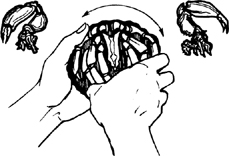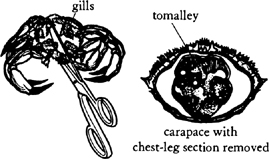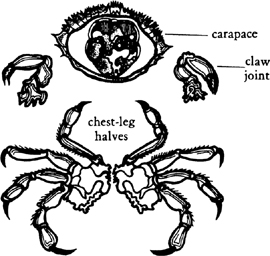Mastering the Art of French Cooking, Volume 2 (16 page)
Read Mastering the Art of French Cooking, Volume 2 Online
Authors: Julia Child

| Break off claw-joint sections where they join the body. |
On either side of the chest, where it fitted into the shell, are feathery, spongy strips, which are the gills; pull off and discard them. Scrape the creamy tomalley out of the chest with your fingers and a spoon handle; place in a sieve set over a bowl. |
|
With a vegetable brush, scrub shell on underside of chest and around the legs under a stream of cold water; scrub the claw-joint pieces also.
Finally cut the chest in half lengthwise as shown
. (Trim off any mossy bits of shell with a knife or scissors.)
| You now have prepared for cooking the chest-leg sections, which are cut in two, and the claw-joint sections. The other edible portion of the crab is the rest of the tomalley, which is in the carapace. |
Crab tomalley
The greenish, brownish, and sometimes orange creamy matter left in the carapace is also called tomalley. It, along with the juices in the shell, constitutes some of the best parts of the crab.
*
Pour the juices through the sieve containing the chest tomalley; scoop soft matter out of the shell with your fingers, and into the sieve. When all the crabs are done, pour accumulated liquid into a separate container and reserve. Rub the tomalley through the sieve with a wooden spoon, scrape it off bottom of sieve into a bowl; reserve for Step 7, where it will simmer with the crab-meat garnish. (After puréeing, the raw tomalley will become a rather dark green, which then becomes dark red when cooked.)
*
When a whole crab is boiled, the tomalley turns greenish and orange while the liquid usually becomes white.
HOW TO REMOVE THE MEAT FROM COOKED CRABS
Provide yourself with a board and wooden mallet or wooden object of some sort for cracking the shells, and a grapefruit knife for extracting the meat. For a bisque made from small crabs, do not bother to delve too thoroughly because it will take all day; remove only what meat you easily can, and the shell debris will be simmered again anyway to extract all remaining flavor. Begin by twisting the legs from the chest sections, then break each leg off at the knee by bending it back upon itself at the joint, thus drawing the cartilage out of the upper leg meat. For a
bisque, chop lower legs into quarter-inch pieces, and reserve for shellfish butter; otherwise discard them. To remove meat from upper legs, as well as from claws and joints, crack shell sharply but lightly with mallet, being careful not to shatter the shell into the meat. Then dig out what meat you easily can with the point of your grapefruit knife. To remove meat from chests, dig out what you can from the holes left by the legs, then from the other side, being careful not to include bits of shell or cartilage. You will get about 1 solid cup of meat from 6 to 8 crabs measuring 3 to 4 inches across the back of the shell.

BISQUE DE HOMARD À L’AMÉRICAINE
[Lobster Bisque]
Considering the price of lobsters and the puréed nature of a bisque, we think it is a waste to use whole lobster here. We therefore suggest only the chests and the legs for the bisque, and the tails, claws, and tomalley for a splendid main dish, such as the
homard à l’Américaine
described in Volume I on page 223. In fact, you could well combine the two, starting them out together, since both follow much the same pattern. Serve the main dish one night, and the bisque a day or two later. That is up to you, however, and we shall content ourselves with the chests and legs from 3 or 4 lobsters for the following recipe. As in most dishes of this type, you can expand or contract the ingredients to a certain extent without upsetting the balance of tastes, and you need not be disturbed if you have a little more or a little less of anything that is called for.
A NOTE ON TECHNIQUES AND EQUIPMENT
In the old days you would have needed an 8-quart marble mortar, a large wooden pestle, a 12-inch tamis sieve, a tortoise-shell scraper, and either a flock of kitchen minions or the strength of a Japanese wrestler to produce a proper bisque.
Today’s electric blender eliminates these colorful requirements, but there are still multiple simmerings, strainings, and puréeings, as well as numerous bowls, sieves, and spoons that you will need. Do not wash anything off until the soup is done because you will be using the same utensils repeatedly and you don’t want any marvelous tidbits of flavor losing themselves down the drain.
For about 2 quarts, serving 6 to 8





